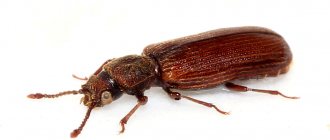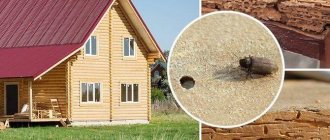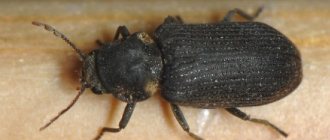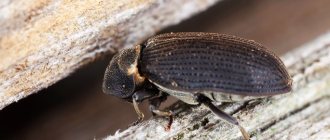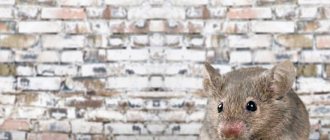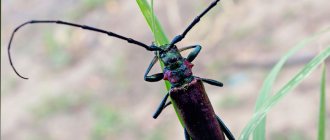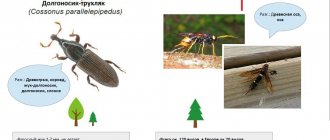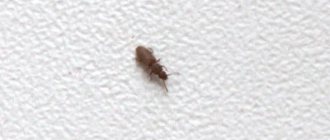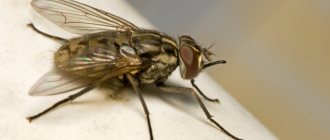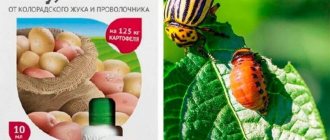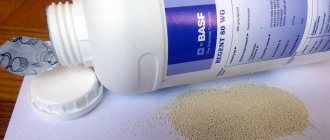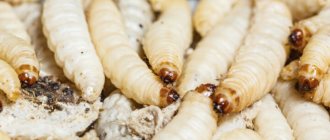Residents of city apartments rarely encounter bark beetles, but for owners of dachas and private houses this is a common problem. It is quite difficult to get rid of the bark beetle, which is due to the rapid growth of the population under favorable conditions. Pests spoil trees on the site, damage wooden floors (floors, ceilings, walls), furniture and interior items. If measures are not taken in time, in a couple of years they will completely destroy housing and all plantings.
The wood borer is a small insect that feeds on wood, destroying its structure. Of particular danger are beetle larvae, which are voracious and capable of eating up to 10 g of wood fibers per day.
We have collected the most effective methods and means that will help you fix the problem yourself and save the wooden structure. The choice of method depends on the scale of the disaster.
Features and danger of bark beetles
The bark beetle is a small insect that feeds on wood. Pests go through several stages of development:
- Eggs . After mating, the adult female gnaws her way deep into the tree, where she leaves the clutch.
- Larva . From the moment the eggs are laid to the next stage, an average of 7-10 days pass. The larvae are small white-transparent worms that are voracious. By eating the sap and fibers of the tree, they move inside the trunk and leave passages behind them.
- Doll . The period of transformation of a larva into a pupa takes on average 2-3 years.
- Adult . The beetle reaches a size of 4-6 cm, the surface of its body is covered with a chitinous shell of dark brown or black color, and there are club-shaped antennae on the head. Appearance may vary depending on the type of insect.
The borer goes through 4 stages of development: eggs, larva, pupa, adult
It is better to start pest control at the larval stage. However, it is quite difficult to find them, since they are located deep in the trees, do not crawl out and are able to withstand temperature fluctuations from −30 to +38 ℃.
Bark beetles are found primarily in temperate regions. Their favorite wood is spruce, fir, pine, cedar, and in the absence of these species, they do not disdain other trees. In this case, preference is given to wood affected by the fungus.
The bark beetle poses a danger not only to trees in the garden, but also to wooden buildings (baths, houses, sheds, gazebos), as well as pieces of furniture
The main danger of pests is damage to trees or wood products. They eat wood, breaking through passages and spreading fungal spores through them, which accelerates the destruction of the tree from the inside. Therefore, a tree that is intact and healthy on the outside may turn out to be rotten on the inside. This is especially dangerous for load-bearing structures and supports, which can collapse at any moment, causing significant damage.
Bark beetles do not pose a danger to humans. They do not bite, do not transmit infections and do not provoke allergic reactions. But for houses and furniture made of wood, small bugs can be destructive.
Traces of a bark beetle on a tree - how to detect?
It is not difficult to determine that pests have settled on a tree. Typically, the insect targets weakened plants. It is on such trees that beetles make their nest, without attracting attention to themselves and without wasting energy on damaging healthy hard wood. Therefore, first of all, weakened plants should be inspected for the presence of insects.
Round and oval holes can be seen on the trunks of affected trees. Such traces will mean that the worms have settled in the tree trunk a long time ago. A woodpecker constantly working on a tree can also be considered a sign of defeat. Most often, the bird hunts for the bark beetle.
Sawdust, which insects throw out of the trunk, forming passages under the bark, can also be considered a sign of infection. Based on the color of the sawdust, you can determine the level of damage to the tree: brown - the bark beetle did not have time to penetrate deep under the bark, white - spraying and any other treatment will most likely not give results, since the insects managed to get too deep.
Causes and signs of appearance
The main reasons for the appearance of bark beetles in wooden houses:
- high humidity, which leads to wood damage by fungus;
- improper or insufficient wood processing;
- use of low-quality materials for construction;
- purchasing wooden furniture made from infected wood.
It is almost impossible to identify pests in a residential area, since they settle deep in the wood, and crawl out only when the raw material becomes unsuitable for life and food. However, if you are careful, you can notice the first signs of pests. Upon careful examination, small holes (up to 2 mm in diameter) and remains of brown flour (recycled wood) are found, and rustling noises are heard at night.
In the garden, a visual inspection of the trees will help determine the presence of pests - they begin to dry out, and the passages of the borer can be seen under the bark. You can see what it looks like in the photo below.
The appearance of bark beetles is indicated by the presence of small holes and passages that are visible under the bark of trees or on affected wooden products
What is the harm?
The problem of wood damage may lie not only in improper storage conditions or maintenance of a house built of wood, but also in bugs that usually infest such houses. They can appear in warehouses where boards or logs are stored, in gardens where trees and shrubs grow . In a word, wherever there is something wooden, it serves them as food, as well as for building their nests and raising their offspring.
Typically, such a beetle chooses the weakest, sickest tree or old furniture , floorboards, ceilings, or noticeably aged sections of log walls that are not protected by any coating. It’s easy to understand that you have an insect that loves wood - just look if there are such peculiar paths or small holes on it, which are usually lightly powdered around the edges, sprinkled with wood dust . If you do not remove such bugs, the tree (or wooden product) will soon lose its strength and integrity .
Mechanical methods of pest control
A radical way to get rid of bark beetles is to dismantle and burn the affected wood. This method is used in exceptional cases, as it has a number of disadvantages:
- damage to the integrity of wooden structures is required;
- it is impossible to be absolutely sure that the remaining elements of the structure are not affected by pests;
- effective only at the initial stage of bark beetle reproduction.
XILIX Gel
XILIX Gel gets rid of all wood pests. This professional biocide effectively removes mold, mildew, insects, and larvae. It also treats affected areas of houses and forms effective protection.
How XILIX Gel works
The drug protects and rids wood of parasites. The white gel-like substance acts as an insecticide. Contains permethrin (0.51%), which resists sucking and leaf-eating pests. Eliminates organisms resistant to organophosphorus insecticides. The drug is dangerous for cats .
A gel with significant penetration properties penetrates deeply to a distance of 10 cm from the surface and does not drain. Kills adult insects and larvae. Propiconazole in the composition prevents the appearance of mold and fungi. Fungal spores do not settle on the surface of the wood product. Due to the thixotropic formulation, the drug acts without loss of properties in a thick wood layer. The number of passes to obtain a therapeutic effect is reduced.
Benefits of the gel
XILIX Gel is an innovation in methodological approaches to getting rid of tree pests. Advantages:
- resistance to mold, mildew, wood pests, including larvae, eggs;
- deep penetrating ability due to a special formula;
- Possibility of use outside and inside housing;
- long-term preservation of the effect (there will be no secondary infection for 10 years);
- safety for humans, the environment and pets (excluding cats);
- suitable for all wood species;
- does not change the color of the wood, does not leave stains;
- no smell;
- acceptable cost.
The best place to order XILIX GEL treatment is from. The specialists passed prof. training and have all the necessary equipment to provide the highest quality services.
Preparation for the procedure and application of XILIX Gel
Before processing, you need to consider: the use of XILIX Gel requires professional assistance, since special equipment is used. Xilix Gel is applied by spraying with a painting unit with a hydrodynamic pump:
- GRACO;
- WAGNER;
- TITAN.
First comes the preparation of the wood. It is cleaned of dirt and dust. Old paintwork or other coatings are removed. The wood is sanded to remove loose layers using professional equipment. Damaged wood elements must be replaced before applying Xilix Gel.
The gel contains a fluorescent pigment, so you can monitor the quality of the coating. The pigment appears about a month after application of the drug. XILIX Gel is used at temperatures above 0 °C, wood moisture content is not more than 25%.
The product is applied by applying one to three layers to the wood, depending on the thickness, type, and humidity of the substrate under low pressure (maximum 5 bar). In areas where application of the gel is difficult, parenteral injection of the drug into the drilled holes is carried out to ensure complete impregnation. Spraying is important for wood with a significant diameter or wood that is difficult to access from several sides.
Working diagram:
- Inspect the facility, carry out calculations of chemical consumption.
- Prepare part of the base for application.
- Apply the drug.
- Check the results.
Xilix Gel for bugs and fungus
The drug is used for prophylactic or therapeutic purposes. For prevention:
- insect eggs die because they are in the upper woody layer and are the first to be affected by the drug;
- females are unable to lay eggs;
- the larvae present cannot resist the action of the drug and die;
- fungal spores do not settle, do not multiply, and do not survive.
During treatment:
- the drug prevents the formation of mold and fungi;
- The product kills various insects, adults and larvae. The drug is quickly absorbed, penetrates 10 cm from the surface or more, and effectively fights even pests hidden deep inside.
XILIX Gel is an active substance manufactured by a manufacturer from France. Sold in the form of a gel, its purpose is to treat wood to get rid of insects, mold, and mildew. There are no similar preparations in the Russian Federation with a similar formula, thanks to which the gel penetrates into the deep layers of wood. A 10-year guarantee on the effectiveness of the treatment is provided. This is an effective drug for treating wood and preventing destruction due to pests.
XILIX Gel
Fumigation
Fumigation using phosphine or magtoxin gases will help control pests. The poisonous gas penetrates the passages of insects, destroying eggs, larvae, pupae and adults. Carrying out aeration should be entrusted to specialists in order to achieve maximum results in the fight against parasites and avoid poisoning and other negative consequences.
During fumigation, the outside of a wooden house is covered with a special dome, which prevents the spread of gas throughout the area and increases the efficiency of treating the structure.
Disadvantages of fumigation:
- high price;
- the need to attract specialists;
- high toxicity of the gas used;
- After etching, degassing is required to disintegrate the phosphine particles.
Pheromone trap
Mechanical methods of influence include a pheromone trap. This biological method is environmentally friendly, safe for people and animals. The trap is a plastic structure containing a pheromone inside. The beetles flock to the attractive aroma, hit the partition and fall to the bottom of the container, from where they cannot escape. The principle of operation of the pheromone trap is described in detail in the video:
It is important to understand that a pheromone trap is effective for catching only adult individuals, and it can also work the other way around - attracting insects from other territories that will not fall into the trap, but will settle in trees, destroying them.
Microwave devices
Devices emitting high-frequency electromagnetic waves will help fight pests in a wooden house. The microwave emitter heats the wood to high temperatures (+60 ℃), which effectively destroys insects at different stages of development. This method is safe for the building and residents, but requires compliance with certain safety measures, so it is better to entrust the work to specialists.
Bi-58: what it consists of and how it works
Bi-58, a unique drug of its kind, will help fight bark beetles on apple trees and other trees with a fairly noticeable effect.
Just like the previous product, Bi-58 is produced in Germany, in the form of an emulsion concentrate. The product is packaged in canisters of varying volumes from one to ten liters. The main component is dimethoate. Considered safe for humans, but poses a serious threat to bees.
When beetles and larvae enter the stomach, the product has a negative effect on the intestines of insects, causing their death.
The use of folk remedies
Folk remedies will help you get rid of bark beetles in a wooden house. They are used for treating wood with a sponge or spray at home, as well as for filling bark beetle burrows. Effective recipes for killing beetles:
- mix kerosene and turpentine in a ratio of 1:3. Saturate the outside of the wood with the resulting product and inject it into the tunnels using a syringe;
- combine naphthalene, tar and turpentine in a ratio of 1:1:3. Mix all the ingredients and introduce the mixture into the holes left by the bark beetles;
- melt the paraffin and add crushed rosin to it (proportion 5:4). Bring the mixture to a boil, add vegetable oil and simmer for another 2 minutes. Introduce the cooled mixture into the insect passages.
After treating the wood, fill all holes with silicone or acrylic sealant. This will block the escape routes and destroy the insects that managed to survive the first stage of persecution.
To protect against bark beetles, the wood should be covered with hot drying oil. It is used not only for external treatment, but is also poured into insect passages to destroy them.
Use of chemicals
Chemicals help remove the bark beetle by destroying adults and larvae. With their help you can process a large number of products, trees or an entire building. However, you should be careful when working with insecticides, as some products may be harmful to animals or people.
The table contains the most effective chemicals that will help cope with woodworms:
| Name | Active substance | Mode of application | Advantages | Flaws |
| "Bi-58" | Dimethoate | The solution is used for spraying plants and wooden buildings | Destroys bark beetles, their larvae and other beetles | To achieve the effect, re-treatment is required after 3 weeks. |
| "Confidor Extra" | Imidacloprid | The solution is prepared according to the instructions, then it is used to process wood products (furniture, sections of beams, panels, etc.) | Effectively fights adult insects and larvae | Repeated processing required |
| NEOMID StopBeetle | Synthetic pyrethroid | The drug is diluted with water in a ratio of 1:4 and is used to impregnate wooden buildings | Suitable for external and internal processing, penetrates deep into wood, does not interfere with further work with wood | Re-processing is required to maintain the effect. |
| "SenezhInsa" | Stabilized aqueous composition of active substances, including technological and functional components | The solution is used to impregnate wood before use in carpentry or construction. | Penetrates deep into the layers of wood, due to which it retains the ability to repel beetles for a long time | Gives untreated wood a greenish tint |
| "Clipper" | Bifethrin | The product is sprayed on trees on the site, pieces of furniture, and wooden floors. | Good penetration | Re-processing required |
Rules for using pesticides to kill pests:
- Read the instructions on the package.
- Take proper safety precautions - wear gloves, a protective suit, a respirator.
- Follow the instructions to avoid poisoning and other consequences.
- After treatment, take a shower.
If none of the presented methods of combating bark beetles brings the expected result and the pests do not leave the house, use the services of exterminators. To combat insects, they use chemicals and mechanical methods.
Clipper - guarding the health of fruit trees
The Russian-made Clipper product is also suitable for treating trees. Produced in the form of a concentrated emulsion in a 5-liter canister. The drug is based on the active substance bifethrin.
It is used against the bark beetle on fruit trees as an experiment, however, a positive result has already made itself felt in the process of treating plants in Russian nurseries.
The effect of the product lasts for several weeks. The drug can be used in parallel against the typograph bark beetle from the gnawing family, as well as weevils from the sucking group.
Prepare an emulsion that can save the tree, according to the instructions, observing the proportions. The prepared solution is used to spray damaged trees.
Prevention of the appearance of bark beetles in a wooden house
In order to preserve a wooden building and avoid the appearance of a grinder, pay special attention to the selection and preparation of wood:
- check the boards before purchasing, inspect them for small holes or passages;
- choose dry wood, since wet wood contains sap that attracts bark beetles;
- when purchasing logs, examine the ends and make sure there are no tunnels;
- treat the material with insecticides and cover with a protective composition;
- Avoid high humidity in the room, prevent wood from rotting and fungus from spreading.
To build a house, choose high-quality dry wood without fungus and signs of the presence of bark beetles.
When buying a wooden house, pay attention to the condition of the wood and the presence of infection, and when moving into a new building, first carry out antiseptic treatment. For prevention, use the chemicals “Ecolan”, “Antizhuk”, “Wood Healer”, etc. The treatment should be carried out three times with an interval of 7 days, so that you can live in the room without fear.
Assess the condition of wooden furniture before purchasing, as unscrupulous manufacturers may use contaminated raw materials for production. After such a product gets into the house, there is a danger that bark beetles will begin to look for new sources of food, attacking other wooden objects.
An integrated approach, which includes the use of mechanical, folk and chemical methods, will help you get rid of the bark beetle in your home or summer cottage. In difficult cases, use the services of exterminators to save your home and avoid its complete destruction.
How to prepare a house for phosphine fumigation
Let us highlight the main “general” stages of preparing a house for fumigation. This algorithm is not immutable and is always formed taking into account the characteristics of the individual situation.
Stage 1
It is necessary to reliably block all “passages” that should not be contaminated with gas: ventilation ducts, chimneys, communication outlets, basement “vents”.
Stage 2
If the house is protected not by double-glazed windows that are common today, but by more traditional wooden windows (double or single), be sure to seal the frames in several layers with wide and thick masking tape. An important point: the choice of masking (paper) tape is fundamental here, since popular alternatives are not suitable (you cannot use reinforced, stationery or any other tape).
Stage 3
In the case of roof insulation between rafters and insulation thicker than 15 cm, it is important to check the places where the horizontal and vertical surfaces meet - the joints of the roof and walls. In some cases, this space will need to be “sealed” using roll or slab insulation. If only part of the roof is insulated, this part must be “cut off” from the total volume and processed in a different way.
Stage 4
If pests have infested not only inside, but also outside the house, it is necessary to create a kind of “dome” over it. In other words, you will have to fix a dense or reinforced polyethylene layer on the outside (you can also wrap the house with similar material). The purpose of such protection is to seal the structure. However, the need for this arises extremely rarely, since beetles usually prefer to “settle” in the inside of houses.
Stage 5
During fumigation, it is recommended to completely de-energize the building; it is also necessary to remove all equipment (TVs, computers, etc.), personal hygiene items, etc. from the house. Obviously, pets and plants cannot be left in the house either.
Stage 6
Be sure to warn neighbors that for a certain time (usually the full fumigation period is about a week) it is not recommended to come closer than 10 m to the house.
